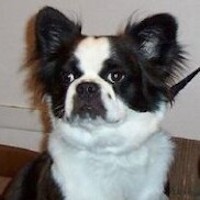Appearance of the Boston Chin
|
| The appearance of the Boston Chin depends on the percentage of the parent breed that makes up the hybrid. They are small and well-shaped, with a more refined build than the square appearance of the Boston Terrier. The head is broad with set almond-shaped eyes, often taking on a distinct oriental expression. The muzzle is short like the two parent dogs and in proportion to their head. They have triangle-shaped ears that are held semi-erect or floppy, depending on genetic makeup. The Boston Chin may have fringed ears, a gift from its oriental heritage. They are graceful dogs with long, tapering tails; again, they can be feathered and carried high on their backs. Their limbs are straight, with short legs and small rounded paws. |
Temperament of the Boston Chin
|
| The Boston Chin is a good companion, somewhat sensitive and intelligent with a streak of independence. It's an elegant little dog with a great personality. The Boston Chin is well-mannered and a quick learner, although if it gets bored, it may choose to do something more interesting. Training sessions should be fun and varied, and if you persist and are patient, they will learn quickly. This is a happy, enthusiastic dog ready for action with the family. These dogs are very playful and reliable with young children and mix well with other pets. Although small, they can be strong-willed if they don't have a strong leader, so they need to be trained and taught acceptable behavior. Fun and charming, the Boston Chin becomes an integral part of family life. |
Needs and activities of the Boston Chin
|
| These dogs need daily exercise to stay in shape, but don't require long walks or hour-long runs. They are companion dogs that thrive when they're with the family they love. The Boston Chin likes a little exercise every day, especially if it takes after the Boston Terrier. They love a walk in the park or playing with the family. Because they're a small dog, take care not to hurt them by falling or stepping on them. The Boston Chin likes a little mental stimulation with games of hide-and-seek or a variety of training. These dogs are totally devoted to their master and will happily sit on your lap and enjoy your attention. If left alone for too long, they can suffer from separation anxiety unless they have the company of another dog or cat. The Boston Chin is well suited to apartment living, although it can easily adapt to a house and yard just as easily. |
Maintenance of the Boston Chin
|
| The Boston Chin requires weekly brushing to control shedding. A good firm brush will remove any loose hairs and keep the house clean. If your Boston Chin has bangs on its body, brushing will prevent it from becoming matted. The Boston Chin inherits the grooming habits of the Japanese Spaniel, habitually grooming to keep clean. Whereas the Boston Chin gets its robustness from the Boston Terrier. An occasional bath as needed with a quality dog shampoo, or between rubs with a damp towel is all that's needed to keep your Boston Chin in good condition. Other maintenance issues include checking for excess debris in the ears and brushing the teeth. Regular nail trimming will complete the care. |









 English (United Kingdom)
English (United Kingdom)